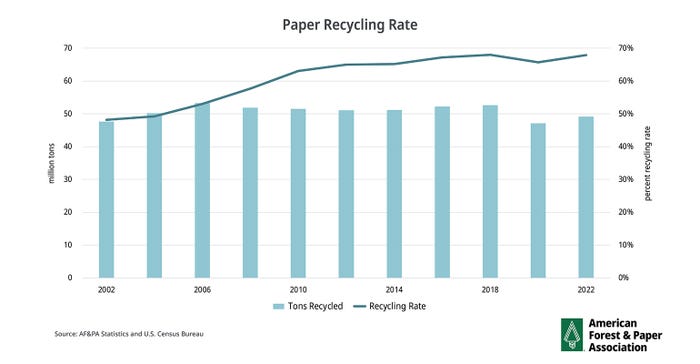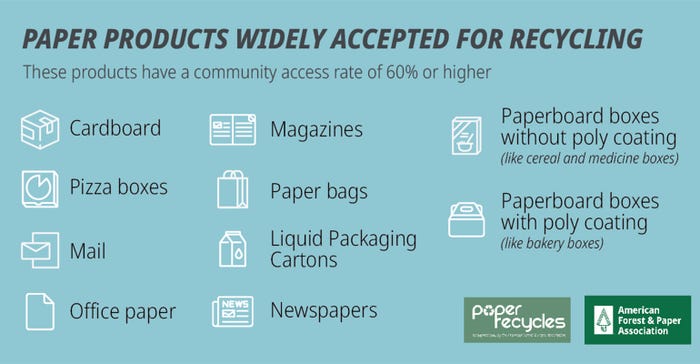America Recycles Day: Celebrating Paper's Recycling Triumphs and Progress
America Recycles Day is the only nationally recognized day dedicated to promoting and celebrating recycling across the United States. Recycling companies and programs will use this day to proudly announce how well U.S. citizens recycle, including the country’s incredible ability to recycle paper and cardboard.

This year, the Keep America Beautiful program is celebrating its annual recycling celebration, aptly named, America Recycles Day. America Recycles Day is the only nationally recognized day dedicated to promoting and celebrating recycling across the United States. Recycling companies and programs will use this day to proudly announce how well U.S. citizens recycle, including the country’s incredible ability to recycle paper and cardboard.
According to Keep America Beautiful, over the last year, volunteers and affiliates for the organization helped recycle over 2.3 million pounds of mixed paper. In Keep America Beautifull’s total reporting, over 16.5 million pounds of recyclables, paper leads the way for materials ahead of electronics, textiles, and beverage containers while only being second on the list to ‘other.’
In fact, more than 2/3 of the paper used in the U.S. is recycled, according to the American Forest & Paper Association (AF&PA). That’s almost 50 million tons of paper being used to make new, sustainable paper products and contributing to a larger, circular economy. The AF&PA reports that, in 2022, the paper recycling rate was 68% and the cardboard recycling rate came in at an impressive 93%, totaling almost 35 million tons of cardboard recycled last year.

But, how is recycling in America so successful? Brian Hawkinson, Executive Director, Recovered Fiber at AF&PA explains that success stems from strong, accessible recycling programs that is helped along in part by the paper industry.
“94% of Americans have access to community paper recycling programs. This robust access yields tangible results. According to the U.S. EPA, more paper by weight is recycled from municipal waste streams each year than glass, aluminum, and plastic combined,” said Hawkinson.
As successful as the U.S. has been at recycling paper, we can always do more, and improving paper recycling has been an industry priority for decades. Since setting a goal to improve paper recycling rates in the 1990s, the rate has doubled.
“Now, we’ve set a goal to increase the use of secondary materials like recycled paper in new paper products to 50% by 2030 as part of our Better Practices, Better Planet 2030: Sustainable Products for a Sustainable Future initiative. This means the industry will use even more recycled paper to produce sustainable, everyday goods,” Hawkinson explained.
“Our industry has invested $7 billion in manufacturing infrastructure, completed, or announced, from 2019-2025. This includes new paper mills, new paper machines, and the conversion of existing paper machines to make products that are more in demand. These investments will use more than 9 million tons of recycled paper.”

Although, there are still factors getting in the way of paper recycling at all levels of production. The paper recycling process isn’t safe from falling victim to ‘Wishcyclers’ as paper can get mixed into recycling bins with materials that can’t be recycled or materials enter a MRF that affects machines and can cause delays, resulting in losing that precious paper altogether. Also, Extended Producer Responsibility (EPR) programs can pose a threat to paper recycling if the material is treated the same way other hard-to-recycle materials are treated.
“EPR is an environmental policy model that requires brand owners, producers, and material manufacturers to manage the end-of-life costs of recyclable products. These programs are a fine way to manage hard-to-recycle materials like batteries, paint, electronics, and mattresses. But unlike these products, paper is a highly recyclable and widely recycled material,” says Hawkinson.
“Many EPR proposals take a “one-size-fits-all” approach that fails to differentiate between highly recycled materials, like paper, and those that are more challenging to recycle or have lower recycling rates. It’s important that lawmakers use a more data-driven approach to ensure recycling policies improve difficult-to-recycle materials without impacting paper’s recycling success.”
America Recycles Day is about celebrating our wins when it comes to recycling and our ability to recycle paper is a huge win. While the U.S. is already so good about recycling paper, we can’t rest on our laurels as there is always room for improvement. Starting in our homes, all the way up to policymakers so that we can achieve higher and higher recycling rates each year.
The 24th America Recycles Day precedes the biggest gift-giving time of the year in the U.S., so, I’ll leave you with this reminder: wrapping paper CAN be recycled.
“Generally, if you can scrunch it up and it stays in a tight ball, it is paper-based and can be recycled. Other wrapping paper varieties made from foil or plastic wrap, or those covered in glitter, should be reused if possible. This holiday season don’t forget that paper recycling is the gift that keeps on giving,” explains Hawkinson.
About the Author
You May Also Like




.png?width=300&auto=webp&quality=80&disable=upscale)